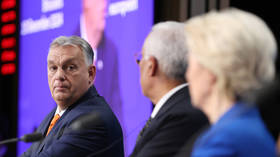Moscow vows reciprocal response after US test of previously banned missile. Here’s what it could be

Russia says it won’t sit idle after the US tested a missile that was banned by the INF. As a response, Moscow has an ace up its sleeves and it won’t need to enter into a Cold War-style arms race, military analysts have told RT.
No longer bound by the milestone Intermediate-Range Nuclear Forces Treaty (INF) – which the US unilaterally scrapped – Washington recently tested a ground-launched version of its Tomahawk cruise missile.
On Friday, Russian president Vladimir Putin said he is not up for an all-out arms race, but ordered the military to evaluate and find reciprocal answers. So, what is Russia likely to have in store to counter the emerging threat?
Viktor Murakhovsky, a military analyst and retired army officer, reminds us that there was an array of weapons whose capabilities were deliberately curtailed to meet the requirements of the INF treaty, which banned missiles with ranges of 500-1,000km (short to medium-range) and 1,000–5,500km (intermediate range).
Also on rt.com Putin orders ‘symmetrical’ response to US missile test, says Washington worked to breach INF“[Russia’s] existing Iskander system, which has been in use with the rocket brigades of our Ground Troops, had a range limitation [under the treaty],” he told RT. Its range “was artificially reduced to under 500km –to 480km, to be precise– and now, when the shackles are gone, nothing prevents our weapons designers from reviving their technological groundwork.”
That would essentially mean that the range of the projectile may be enhanced.
This is the cheapest, the most efficient and, at the same time, is an asymmetric solution.
Mikhail Khodarenok, a retired air defense forces colonel, says that Russia may also seek to restore the tactical missile units that had previously disbanded under the INF.
“For example, several front-line missile brigades armed with ground-based cruise missiles will be deployed ... and the whole thing won’t exceed the existing military budget,” he offered.

The military expert also believes Moscow may soon conduct a launch of a cruise missile similar to the Tomahawk. The likeliest candidate is the seaworthy Kalibr-NK, which has been already used in targeting terrorists in Syria.
On top of that “in the nearest future, Russia will unveil a new ground-launched cruise missile system,” he said.

Another option could be a Club system, which is normally disguised as a shipping container that can be placed on a truck, train, or merchant vessel which allows missiles to be moved and stored without raising suspicion. Like the Iskander, its range was decreased to 300km and its payload to 500kg due to arms treaty restrictions, Murakhovsky told RT.
If delivered to the Russian armed forces without limitations, its capabilities dramatically increase.
Combining top-notch weapons and some proven technology may also help. Here, Murakhovsky said, one can look back at an example of how Russia countered the US withdrawal from the Anti-Ballistic Missile Treaty (ABM) in 2002.
Moscow designed and adopted a single combat system, the hypersonic Avangard glider and “it is mounted on an old-fashioned Soviet missile, the UR-100 [also known as the RS-18A].”
That solution allowed Russia to “reset all US efforts put into ballistic missile systems such as THAAD or Aegis,” and the ratio between Russian and American investments were 1:1,000, according Murakhovsky.
Like this story? Share it with a friend!
Subscribe to RT newsletter to get stories the mainstream media won’t tell you.















